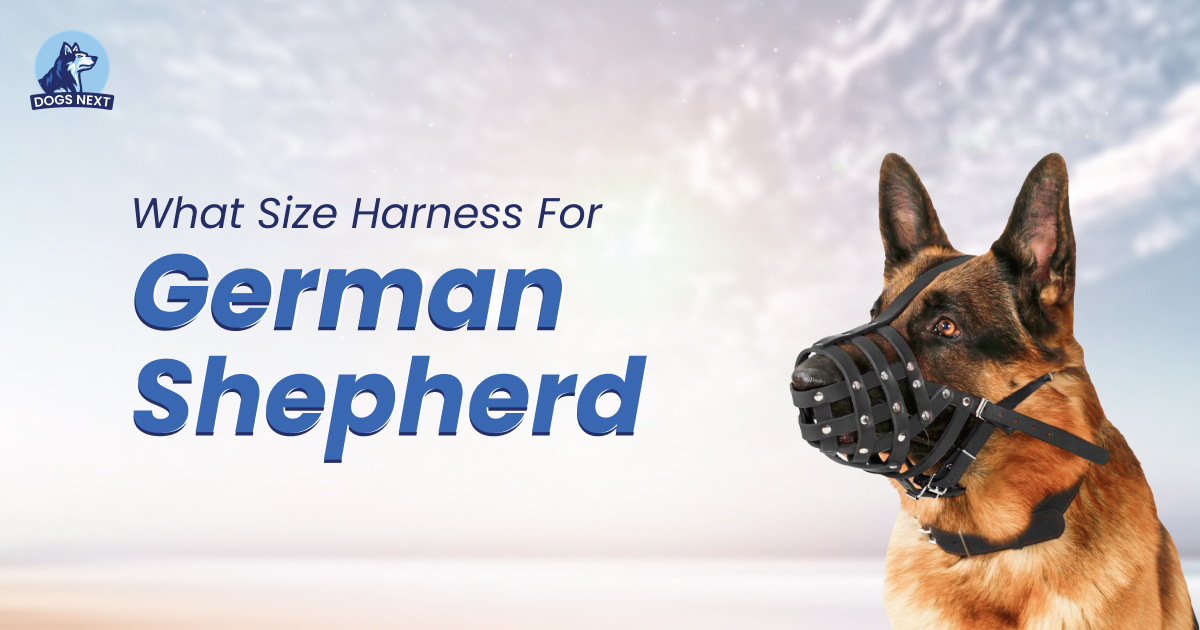Bringing home, a German Shepherd puppy is an exciting experience, but it also comes with the responsibility of providing them with the right equipment, including a well-fitting harness. As your puppy grows, finding the appropriate size harness becomes crucial for their comfort, safety, and overall well-being.
The size of the harness for a German Shepherd puppy can vary depending on the individual puppy’s age, weight, and body structure. It’s important to choose a harness that fits properly and allows for growth as your puppy matures.
In this comprehensive guide, we will walk you through the process of selecting the right harness size for your German Shepherd puppy. From understanding their unique needs to measuring and finding the perfect fit, we’ll cover everything you need to know to ensure a comfortable and secure harness for your furry friend.
Understanding German Shepherd Puppies
German Shepherd puppies are known for their intelligence, loyalty, and energetic nature. As they grow, it’s important to consider their unique characteristicss and growth stages when selecting a harness. German Shepherd puppies have a distinct body structure, with a deep chest, strong neck, and broad shoulders.
Their growth rate can vary, but they generally go through rapid growth spurts in the first year. These factors make it crucial to choose a harness that accommodates their changing body size and provides proper support. Additionally, puppies have sensitive skin and delicate bones, so selecting a harness that is comfortable and gentle on their young bodies is essential. Understanding these aspects will help you choose the right harness that ensures both comfort and safety for your German Shepherd puppy.
Why Choosing the Right Harness Size Matters
Selecting the right harness size for your German Shepherd puppy is more than just a matter of aesthetics. It has a significant impact on their well-being and overall experience while wearing a harness. A properly fitting harness distributes pressure evenly across their body, reducing the risk of discomfort, chafing, or injury. On the other hand, an ill-fitting harness can cause a range of issues.
If the harness is too loose, it may slip off or allow the puppy to escape, putting them at risk of accidents or getting lost. Conversely, a harness that is too tight can restrict their movement, cause discomfort, and even interfere with their natural development.
| Weight Range (lbs) | Neck Circumference (inches) | Chest Girth (inches) |
| 10-20 | 12-16 | 18-24 |
| 20-40 | 14-18 | 22-28 |
| 40-60 | 16-22 | 26-32 |
| 60-80 | 18-24 | 30-36 |
Note: The table above provides general weight ranges, neck circumference, and chest girth measurements to help you get started in selecting a harness size for your German Shepherd puppy. It’s important to measure your puppy’s specific dimensions and consider their growth rate for a more accurate fit.
Measuring Your German Shepherd Puppy
To ensure a proper fit, it’s important to measure your German Shepherd puppy accurately. Here’s a step-by-step guide to help you –
Step 1: Neck Measurement
Using a soft measuring tape, measure around the base of your puppy’s neck. Ensure the tape is snug but not too tight. Record the measurement in inches or centimeters.
Step 2: Chest Measurement
Wrap the measuring tape around the widest part of your puppy’s chest, just behind its front legs. Again, make sure it’s snug but not constricting. Note down the measurement.
Step 3: Girth Measurement
Measure the girth of your puppy’s torso by placing the tape around the deepest part of its ribcage, just behind their front legs. Take the measurement and keep it handy.
Finding the Perfect Harness Size
Now that you have the measurements, it’s time to find the perfect harness size for your German Shepherd puppy:
Refer to Size Charts
Consult the size charts provided by harness manufacturers. Match your puppy’s measurements with the appropriate size range mentioned in the charts.
Consider Adjustable Harnesses
Opt for a harness that offers adjustable straps and multiple size options. This is particularly important for growing puppies as it allows for a customizable fit.
Seek Expert Advice
If you’re unsure about the size, reach out to customer support or consult with a professional dog trainer or veterinarian. They can provide valuable guidance based on your puppy’s specific needs.
Types of Harnesses for German Shepherd Puppies
There are various harness styles available for German Shepherd puppies. Here’s an overview of the most common types and their pros and cons –
Step-In Harness: This harness is easy to put on and great for puppies who dislike having something slipped over their heads. However, it may not provide as much control as other styles.
Vest Harness: Vest harnesses distribute pressure evenly and offer good support for your puppy’s body. They are comfortable and often come with adjustable straps. Keep in mind that some vest harnesses may restrict shoulder movement.
Front-Clip Harness: This type of harness has a leash attachment at the front, which helps discourage pulling. Front-clip harnesses can be effective for training purposes, but they may not be suitable for all puppies.
Consider the specific needs and behavior of your German Shepherd puppy when selecting a harness type. It’s essential to prioritize their comfort, safety, and ease of use.
Measuring Your German Shepherd Puppy
To ensure a proper fit, it’s important to measure your German Shepherd puppy accurately. Here’s a step-by-step guide to help you –
Neck Measurement
Using a soft measuring tape, measure around the base of your puppy’s neck. Ensure the tape is snug but not too tight. Record the measurement in inches or centimeters.
Chest Measurement
Wrap the measuring tape around the widest part of your puppy’s chest, just behind their front legs. Again, make sure it’s snug but not constricting. Note down the measurement.
Girth Measurement
Measure the girth of your puppy’s torso by placing the tape around the deepest part of their ribcage, just behind their front legs. Take the measurement and keep it handy.
Finding the Perfect Harness Size
Now that you have the measurements, it’s time to find the perfect harness size for your German Shepherd puppy:
Refer to Size Charts
Consult the size charts provided by harness manufacturers. Match your puppy’s measurements with the appropriate size range mentioned in the charts.
Consider Adjustable Harnesses
Opt for a harness that offers adjustable straps and multiple size options. This is particularly important for growing puppies as it allows for a customizable fit.
Seek Expert Advice
If you’re unsure about the size, reach out to customer support or consult with a professional dog trainer or veterinarian. They can provide valuable guidance based on your puppy’s specific needs.
Types of Harnesses for German Shepherd Puppies
There are various harness styles available for German Shepherd puppies. Here’s an overview of the most common types and their pros and cons:
Step-In Harness: This harness is easy to put on and great for puppies who dislike having something slipped over their heads. However, it may not provide as much control as other styles.
Vest Harness: Vest harnesses distribute pressure evenly and offer good support for your puppy’s body. They are comfortable and often come with adjustable straps. Keep in mind that some vest harnesses may restrict shoulder movement.
Front-Clip Harness: This type of harness has a leash attachment at the front, which helps discourage pulling. Front-clip harnesses can be effective for training purposes, but they may not be suitable for all puppies.
Consider the specific needs and behavior of your German Shepherd puppy when selecting a harness type. It’s essential to prioritize their comfort, safety, and ease of use.
Factors to Consider When Selecting a Harness
When choosing a harness for your German Shepherd puppy, there are several important factors to keep in mind:
Safety features to look for in a puppy harness: Opt for a harness with strong and secure fastenings, such as sturdy buckles or durable Velcro closures. Additionally, consider features like reflective strips for enhanced visibility during nighttime walks.
Comfort considerations for a growing German Shepherd: Look for a harness made from soft, breathable materials that won’t irritate your puppy’s skin. Adjustable straps and padded chest plates can provide a comfortable fit while accommodating their growth.
Tips for proper harness fit: Ensure the harness is snug but not too tight. You should be able to fit two fingers between the harness and your puppy’s body. Pay attention to the fit around the neck, chest, and girth areas.
Adjusting the harness to ensure a snug yet comfortable fit: Most harnesses have adjustable straps to customize the fit. Take the time to adjust the harness according to your puppy’s measurements for optimal comfort and security.
Checking for any signs of discomfort or restriction: Regularly assess your puppy’s behavior while wearing the harness. Look for signs of discomfort, such as excessive rubbing or chafing. Make adjustments as needed to ensure a comfortable fit.
Features of a Quality German Shepherd Puppy Harness
When selecting a harness, consider the following features to ensure you’re getting a quality product:
Durability: Look for a harness made from strong and durable materials that can withstand your puppy’s active lifestyle. Reinforced stitching and robust hardware are indicators of a durable harness.
Comfort: Choose a harness with padding on the chest plate and straps to prevent chafing and discomfort. A comfortable harness will make walks and outings more enjoyable for your puppy.
Security: Ensure the harness has secure fastenings that won’t easily come undone. Additionally, consider a harness with a sturdy handle on the back for better control during training or in challenging situations.
How Do You Put a German Shepherd Puppy on a Harness?
There are two common types of harnesses for German Shepherd puppies: overhead harnesses and step-in dog harnesses.
Putting in an overhead harness:
- Slip the harness over your puppy’s head, with the front strap resting on their chest.
- Position the harness so that the chest plate sits centered and the straps rest along their sides.
- Bring the two side straps under your puppy’s belly and fasten them securely.
- Adjust the straps for a snug fit, ensuring you can fit two fingers between the harness and your puppy’s body.
Putting in a step-in dog harness:
- Lay the harness flat on the ground.
- Place each of your puppy’s front legs through the designated openings.
- Lift the harness upward and bring the two sides together over your puppy’s back.
- Securely fasten the buckle or Velcro closures on either side of your puppy’s back.
- Adjust the straps as needed for a comfortable and secure fit.
How to Introduce a German Shepherd Puppy to a Harness
Introducing your German Shepherd puppy to a harness requires patience and positive reinforcement. Follow these steps for a smooth transition:
- Familiarize your puppy with the harness by letting them sniff and investigate it before attempting to put it on.
- Start by putting the harness on your puppy for short periods indoors, gradually increasing the duration over time.
- Associate the harness with positive experiences by offering treats, praise, or playtime while they wear it.
- Engage in low-key activities or play with your puppy while they’re wearing the harness to create positive associations.
- Gradually introduce walking on a leash with the harness, starting in a familiar and calm environment before venturing into busier areas.
Frequently Asked Questions
Q: What size harness should I get for a German Shepherd puppy?
Ans: When selecting a harness for a German Shepherd puppy, measure its neck, chest, and girth, and choose a size that corresponds to their measurements as per the manufacturer’s guidelines.
Q: What type of harness is best for a German Shepherd puppy?
Ans: The best type of harness for a German Shepherd puppy depends on their specific needs and preferences. However, a well-fitted, adjustable harness with sturdy construction and comfortable padding is generally recommended.
Q: What size harness should a puppy wear?
Ans: The size of the harness a puppy should wear depends on their breed, age, and individual measurements. Measure their neck, chest, and girth to determine the appropriate size as per the manufacturer’s guidelines.
Q: What size harness for a kg puppy?
Ans: It is essential to measure a puppy’s neck, chest, and girth in centimeters or inches rather than relying solely on weight. Follow the manufacturer’s guidelines to choose the right harness size based on the measurements.
Q: What size harness for a Pitbull?
Ans: To determine the right harness size for a Pitbull, measure their neck, chest, and girth and refer to the manufacturer’s sizing guide. Different Pitbulls may require different harness sizes based on their measurements.
Q: What size harness for a Golden Retriever puppy?
Ans: Golden Retriever puppies vary in size, so it’s crucial to measure their neck, chest, and girth to determine the right harness size. Consult the manufacturer’s sizing guide to ensure a proper fit for your Golden Retriever puppy.
Conclusion
By considering factors such as safety features, comfort considerations, and proper harness fit, you can ensure that your puppy’s harness provides the perfect fit as they grow.
Remember to prioritize durability, comfort, and security when selecting a quality German Shepherd puppy harness. Look for features like reinforced stitching, padded chest plates, and secure fastenings to ensure a long-lasting and comfortable experience for your furry friend.
When putting on a harness, follow the appropriate method, whether it’s an overhead harness or a step-in dog harness, ensuring a secure and snug fit. Take the time to introduce your German Shepherd puppy to the harness gradually, using positive reinforcement and creating positive associations.
By following these guidelines, you’ll be able to find the right size harness for your German Shepherd puppy, allowing them to enjoy their adventures while keeping them safe and comfortable. So, the next time you ask yourself, “What size harness for a German Shepherd puppy?” remember the importance of measuring, fitting, and selecting a quality harness that meets their specific needs.

I’m David, an expert contributor and writer, with two furry friends of my own, I know the challenges of raising and caring for dogs. From training to nutrition and health, my goal is to provide valuable insights and advice to help create strong bonds and happy, healthy lives. Find me in Twitter.




